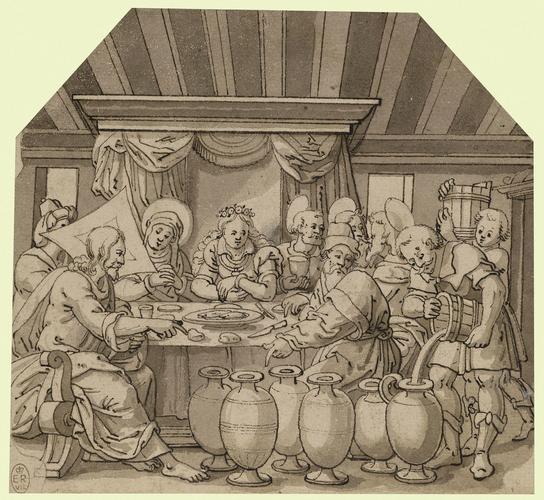The Wedding at Cana c.1550
Pen and black ink with grey wash over leadpoint | 13.7 x 15.0 cm (sheet of paper) | RCIN 912166
-
This small drawing shows Christ's miracle at a wedding feast in Cana, recounted in the Gospel of St John. When the wine ran out at the feast, Christ ordered the jars to be filled with water, which, when tasted, had turned into wine. The drawing shows the servants filling the jars under Christ's instructions, watched by the bride, who sits at the centre of the table. The woman to the left of the bride is the Virgin, who alerted Christ to the absence of wine at the feast, while some of the Apostles, indicated by their halos, sit round the table.
Although it has been dramatically trimmed, it is possible to tell that this work was a design for a panel of stained glass which would have been framed by a pillared canopy, here indicated by the blank spaces left by the artist to the bottom left and right, and also slightly visible towards the top on the left-hand side. That the artist has not needed to delineate the details of the canopy make clear that this was one of a series of scenes in uniform frames, which it was unnecessary to repeat on each design. Drawings were used at a number of stages in the production process: as initial exploratory designs, as contract drawings for patrons to study and approve and as scale drawings used by the glazier as a model for the final panel. This drawing may have been either an initial design or a drawing made for presentation to a patron, since it does not bear any of the working marks, such as colour notations or indication of lead lines, which might suggest it had been used by a glazier; it is also unlikely to be drawn full size.
Although no glass related to this design is known, what seem to be panels after drawings from the same series survive in the Schweizerisches Landesmuseum in Zurich. These show other scenes from the Life of Christ, among them the anointing of Christ's feet in the house of Simon Pharisee and the nailing of Christ to the Cross. In each of these scenes Christ has the same distinctive, diamond-shaped halo and the figures are in ornate dress with large collars and sleeves, often with their forearms bared. Each is a Wappenscheibe, or heraldic panel, commemorating a particular patron. The panels in Zurich come from Kloster Rathausen and date from the 1590s; a panel showing the wedding at Cana, dedicated to Abbot John Theobald von Rheinau and dated before 1598 is known to have been among the group, but is now lost. The panels probably represent a later reuse of designs from the series, since they are all in slightly different canopies and are dated over a period of a few years; it has been suggested that they were based on designs from the circles of Dürer and Holbein. Stained-glass designs were commonly retained in glaziers' workshops and reused, sometimes for some decades.
Although the artist of the drawing has not been identified, his use of pen and ink and grey wash and delicate modelling may suggest that he was working in the circle of the Holbein family. The design bears some similarities to the drawings of Jorg Schweiger (?1470/80-1533/4) - a number of which survive at Basel - who was clearly familiar with the work of Holbein. The artist of this drawing was probably working in the same milieu, and the later reuse of the designs at Kloster Rathausen, near Lake Lucerne, supports a Swiss provenance. A design for stained glass at Chatsworth, heavily reworked by Peter Paul Rubens, may be by the same hand.
Catalogue entry adapted from The Northern Renaissance. Dürer to Holbein, London 2011Provenance
In the Royal Collection by c.1926
-
Creator(s)
(artist) -
Medium and techniques
Pen and black ink with grey wash over leadpoint
Measurements
13.7 x 15.0 cm (sheet of paper)
Other number(s)
RL 12166










